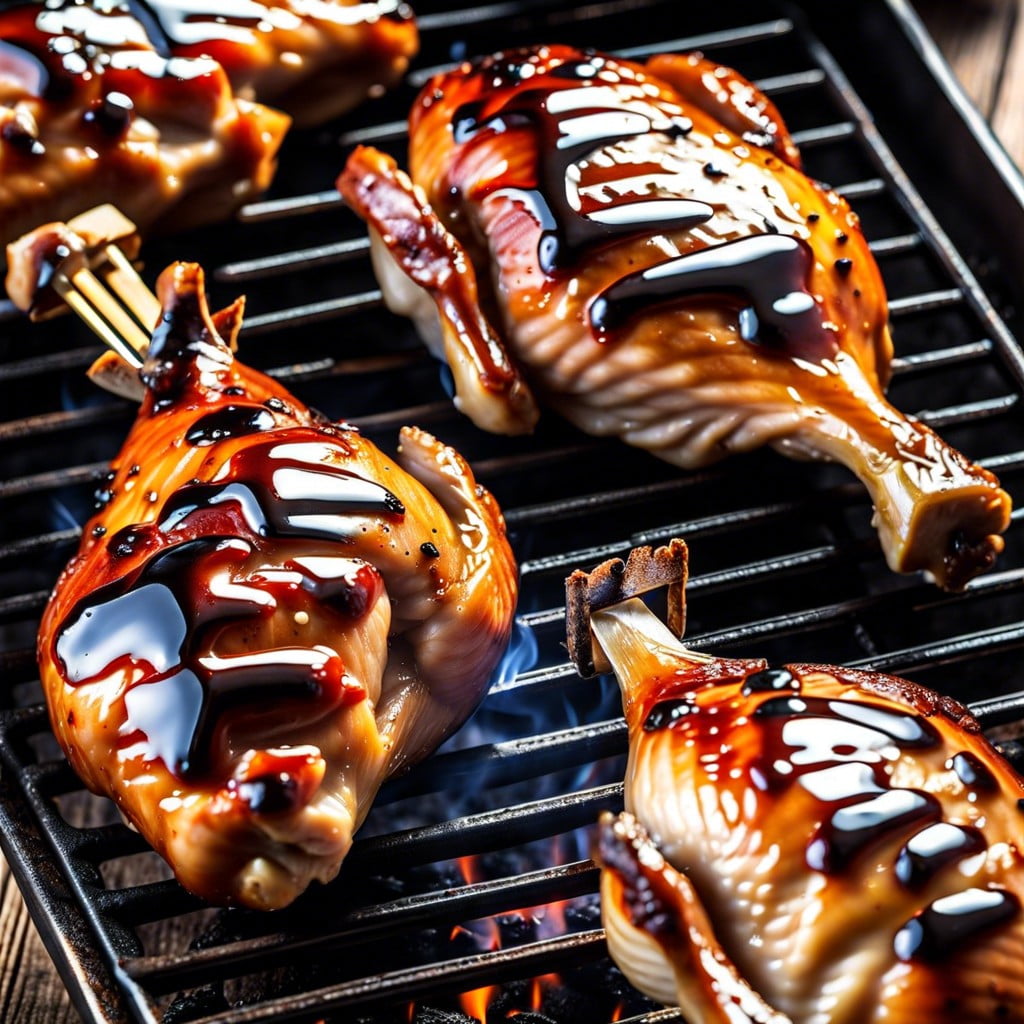Grill your chicken to perfection by understanding the key factors that impact cooking time, which this guide will illuminate.
Key takeaways:
- Time: Boneless chicken breast needs 8-12 minutes on the grill.
- Temperature: Preheat the grill to 350-450°F and use a meat thermometer to reach 165°F internal temperature.
- Technique: Use the two-zone method for searing and cooking through without burning.
- Grill boneless chicken breast for 5-7 minutes per side.
- Check doneness with a thermometer, clear juices, opaque flesh, firm touch.
Time, Temperature and Technique

Grilling chicken is about more than just watching the clock. It’s critical to achieve a balance between time, temperature, and technique to ensure your chicken is perfectly cooked — juicy on the inside and beautifully charred on the outside.
Time: This varies based on whether you’re cooking bone-in, boneless, thighs, or breasts. An average boneless chicken breast will need about 8-12 minutes total.
Temperature: Always preheat your grill to a medium temperature, around 350-450°F. Use a meat thermometer to ensure chicken reaches the safe internal temperature of 165°F.
Technique: Mastering the flip is crucial. Avoid flipping the chicken too many times, which can prevent the outside from getting that desired sear. Using the two-zone method, with one side of your grill hotter than the other, allows you to sear the meat and then move it to a cooler part to cook through without burning.
How Long to Grill Boneless Chicken Breast
Grill boneless chicken breasts for approximately 5 to 7 minutes per side. Optimal grilling time is contingent upon thickness and temperature, typically at a range of 350°F to 450°F. Prevent overcooking by using a meat thermometer, aiming for an internal temperature of 165°F to ensure juiciness and safety. Preheat the grill to create sear marks, and remember to let chicken rest for 5 minutes post-grilling to retain moisture. Keep the lid closed as much as possible to maintain a consistent temperature and promote even cooking.
How to Tell When Chicken Breast Is Done
Ensuring that chicken breast is fully cooked without being overdone hinges on recognizing a few key indicators. Use an instant-read thermometer to check if the internal temperature has reached 165°F, which is the safe threshold according to the USDA. To do this, insert the thermometer into the thickest part of the breast and wait for a stable reading.
Visual cues can also be informative. Look for juices running clear without any hint of pink. The flesh should appear opaque throughout, not translucent. If you make a small cut into the thickest part of the chicken, the meat should be uniformly white.
For those more experienced, touch can be a guide; the meat should feel firm, not jiggly or overly stiff. Remember, resting the chicken for a few minutes after grilling allows the juices to redistribute, which can provide a more accurate assessment of doneness when verifying these factors.
What Temperature Should I Grill Chicken Breasts
For optimal results, preheat your grill to a medium-high heat, which typically falls between 375°F to 450°F. This range is key for searing chicken breast on the outside, sealing in those flavorful juices, while ensuring the inside cooks evenly.
Grilling over a consistent temperature also reduces the risk of undercooked or overcooked chicken. Be mindful to adjust the heat as needed – grilling is not a one-temperature-fits-all endeavor, and subtle shifts in heat can make the difference between a juicy breast and a charred one.
Utilize an instant-read thermometer to confirm internal temperature reaches a safe 165°F, as color and texture can deceive. This tool is your best ally in delivering perfectly grilled chicken breasts to the table every time.
Remember to allow the meat to rest for a few minutes off the heat; this enables the juices to redistribute, maximizing tenderness and flavor.
Do You Grill Chicken On Direct or Indirect Heat
Utilizing both direct and indirect heat optimizes chicken grilling. Begin over direct heat to sear and crisp the skin, rendering fat for flavor. Transfer to indirect heat afterward, letting the chicken cook through without charring. The dual approach yields a balanced exterior and evenly cooked interior.
Thicker cuts benefit from this method, as direct heat alone often leads to an overcooked surface before the inside reaches a safe temperature. Use a thermometer to ensure the chicken is cooked to the proper internal temperature of 165°F (75°C). This technique mitigates flare-ups and prevents drying out, ensuring a juicier, more succulent result.

